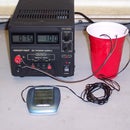Introduction: Build an Ultralight Portable Buck Saw
There are portable buck saws on the market, but they suffer from three problems: 1. They are too small for heavy work, with typically only a 12" blade. 2. They are too heavy. You might argue otherwise, but they are over 20 times heavier than what I'm about to describe. 3. They are too expensive, with good quality collapsible ones in the $30-$40 range.
In this instructable I'll describe a fully functional buck saw you can make out of materials found in the wilderness plus a few light items you need to bring with you.
Step 1: Materials
Bring:
- 18" to 24" buck saw blade ($5 at most hardware stores)
- 2 large cotter pins
- 4ft of strong cordage
- 1 forked branch about the length of the saw blade and about 1" in diamter
- 2 straight branches about 12" long and about 1" in diameter
- 1 straight branch about 6" long and 1/2" in diameter
Step 2: Assembling the Frame
For light sawing (notches for bows and that sort of thing) the blade can be used all by itself. For heavier work (cutting down trees or bucking deadfall into firewood sized lengths) a frame can be built. Use the saw blade itself to cut a slot into one end of each of your 12" pieces. Be careful with the blade. Not surprisingly, it's sharp. You can wrap it with cloth or other material so you can grip it without cutting your hands. Cut the slot to a depth of about 1".
Assemble the pieces on the ground in about the right orientation (as shown in the picture below). Wherever one piece of the frame mates with another, you should do some carving in order to make the pieces fit better so they won't slip once the frame is tensioned.
You may have to attempt installing the blade and tensioning the frame a few times, each time disassembling and carving away more material in different places to get everything to fit nicely.
To assemble the frame, insert the blade into the two slots you cut and insert the cotter pins through the holes in the blade to prevent the saw from sliding out of the slot. Place the forked piece in the middle and tie your cordage in a big loop joining the opposite ends of your 12" pieces as shown. Insert your 6" piece in the center of the loop and start twisting it up until you have applied tension to the blade. Trial and error will determine a good tension: tight enough to tension the blade and hold the saw together, but not so tight that you break your frame. Once the blade is tensioned, let your 6" piece rest against the forked branch to prevent the cordage from untwisting.
With a little practice, it takes about 20 minutes to build this saw from scratch, not including the time to find the appropriate materials.
It is a surprisingly effective saw capable of cutting down large trees if necessary. It is incredibly cheap. If you carry just the cordage, blade, and cotter pins it is incredibly light weight. It's one drawback is that you have to build the frame with materials on site. However, when materials are scarce, and you can afford the extra weight, you can carry your disassembled frame with you. It's still lighter and cheaper than most portable buck saws on the market.
This type of saw has been described in Northern Bushcraft by Mors Kochanski. I collect books related to extended survival and self sufficiency in the wilderness, and it's one of my favorites.













